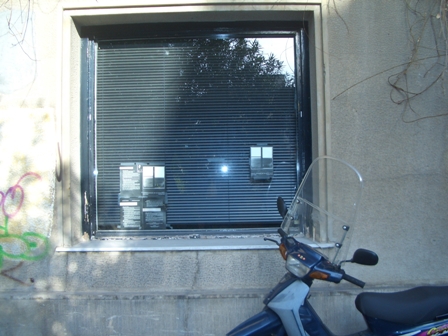In the shadow of Guernica
Shadows have different meanings. It depends on the time zone but also what meaning is implied when saying the shadows grow longer.
Shadows of plants at the cafe 'nice & easy' in Kolonaki, Athens
There is, of course, Albert Camus' 'l'etranger' who walks along a beach when the sun is about to stand at the highest peak of the day. That is when danger looms. It is not only that the sun blinds so that one cannot see who is coming towards one along that beach. There is as well the saying when man casts no longer any shadow, then he is dead.
The growing shades meant always for children the day is coming quickly to an end and they must return home. The end of play was matched by a sadness which blended in with the shades while still trying to figure out how come light disappears? The sun was too far away to ask such a question.
Shadows on the ground

Shadows on Lycabettou Hill in Athens, Greece @hf
There are many associations to be made when speaking about shadows on the ground. They do not really lie there but are cast but they have every appearance of being stuck to the ground. Yet minutes later the earth has continued its rotation but the saying has it that it was the sun which had moved on in the meantime.
Stepping on your own shadow
Children love to step on their shadow or else are frightened if the shadow follows them wherever they go. Naturally if they step inside the house then the shadow disappears if only to reappear once the light is turned on.
Shadow theatre
Shadows cast against walls by playing with the hand and fingers can become a kind of home theatre.

Phil Cooke presenting his viewpoints during 'Myth of the City' conference in Crete 1995
Shadows underneath the eyes
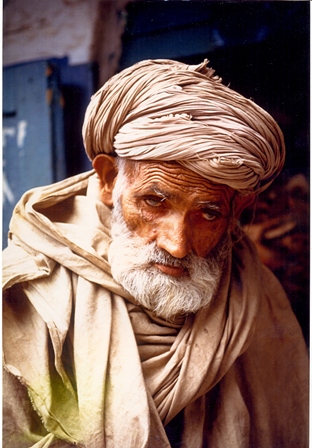
Photo by Izzet Keribar
There are the shadows underneath the eyes. Especially children notice those dark strains when their mothers are overworked, she has hardly time to come home and to cook for the hungry children. That strain of life upon single mothers does not go unnoticed.
Robert Bly in "WARNING TO THE READER"
He wishes to warn readers that they might experience the same fate as birds trapped in barns emptied by time and economic drought with light shining only through the cracks in the wooden walls. They fly towards these cracks over and again but exhaust themselves in doing so as there is no escape.
"Sometimes farm granaries become especially beautiful when all the oats or wheat are gone, and wind has swept the rough floor clean. Standing inside, we see around us, coming in through the cracks between shrunken wall boards, bands or strips of sunlight. So in a poem about imprisonment, one sees a little light.
But how many birds have died trapped in these granaries. The bird, seeing the bands of light, flutters up the walls and falls back again and again. The way out is where the rats enter and leave; but the rat’s hole is low to the floor. Writers, be careful then by showing the sunlight on the walls not to promise the anxious and panicky blackbirds a way out!
I say to the reader, beware. Readers who love poems of light may sit hunched in the corner with nothing in their gizzards for four days, light failing, the eyes glazed. . . . They may end as a mound of feathers and a skull on the open boardwood floor . . ."
–Robert Bly [from: WHAT HAVE I EVER LOST BY DYING? Harper Collins, 1992]
Note:
This warning to the readers became known thanks to Norb Blei in the United States. Norb Blei is a wonderful editor and more a discoverer than just a simple publisher of unnoticed poetry or poetry bygone. He has made it into his eternal task to fetch poets into the public light before they disappear.
http://bashosroad.outlawpoetry.com/robert-bly-warning-to-the-reader/robert-bly/haiku/
Comment:
There is something about the danger of light coming through the cracks in the barn which touches upon something else. This is because another warning is needed about poets themselves. At times they are so much trapped in their own world, that they cannot envision people working together. For that to happen and to experience this a commitment to life is needed (Jean Paul Sartre). Only then will the poet not produce a myth about impossibilities but support that people learn out of experience how to work together. Only then will it be possible to find together solutions i.e. not to head for the cracks but for a proper opening in order to leave altogether the barn in which people have been trapped in for too long a time. That would mean opening the doors and stepping out in full day light. It might blind the eyes for a moment but then humanity never survived from just from blind hope. As Albert Camus said, "to hope is to resign and to live is not to resign!"
As this is said while people in Egypt attempt to do just that, namely to step out of self inflicted blindness about power and what it means to take democracy into your own hands, I did send as comment to the warning by Robert Bly this poem to Norb Blei:
thoughts fade away into the grey sky,
dexterity is the name cast into the sea
when forgotten are kisses by strangers
no longer called Judas
for the voice of betrayal comes from within
as the darkened soul fears nothing more
but the light which can brush away shadows,
those grey figures of power and abuse
always looming large and tall
in the corner of the eye
imagining a blue bird singing the song of freedom
like Egyptians used to near the Nile
HF Athens 5.2.2011
See:
In Greece there is always light in the shades

Dafnomili Street in Athens
In Greece there is one wisdom practiced all the time. Similar to Brussels where it always rains and one walks therefore along that side of the street where maybe some roof or other forms of shelter protect one a bit from the rain, in Greece it is best to stay on the side of the shade. There it is always cooler and it is easier to see from the darker into the brighter side. Given this background, it is understandable that those living in the South have a different association with shade equals black.
and then there is the play of light

Three sources of light: sun set, flood lights of playground and flash of camera on the cars @HF

Sun set in between houses along Lycabettou Street in Athens @hf
Naturally light and shade can be captured by images made with a digital camera, but there is a wish to go beyond the mere image. This can be done by entering not only the contrast between image and the written word (or text), but also to start a dialogue between image and poem. Naturally it is impossible to hide or to paint over a loss of a true love while painting freshly houses in preparation of the Olympic Games in Athens 2004 or thereafter is that much easier. Once colors have been added to the usual grey tone, the interface with the city and its houses changes. It is a question what does then enter this dialogue between image and poems when thinking of shades in poetry as signs of deep sadness, of human pain, of tears never shed in time to protect the soul against this termination of love. The latter had been a source of light.
Shades in poetry- Hatto Fischer
Lycabetou Stairs
Stairs cast in magical light,
The dog waiting there
While the shadow seems to peer ahead
As to who may descend besides Nothingness
When thinking Duchamp’s naked beauty
Has vanished in the Athenian maze
No more to be seen once she left
The dream at the top of the stairs
Wondering if Vermeer’s blue
Would make her return one day
To the Likavitos hill in search
Of her own self having gone astray
In some other light and glare
Of a man becoming a woman
To outpace her destiny
Fixated at the bottom of the stairs
And still waiting in the Phileon café
In expectation of the book
To have been completely read
So that life could begin again
By climbing up to greet the sky
Finally coming down to words
Saying nothing more, nothing less
That desire for love on this very day
Is needed foremost and not alone.
Hatto Fischer Athens 20.1.2007
Half shades
Evidence of the photo club in Kolonaki, Athens having closed down in 2006
Half shades, my fellow, do not become your face,
You need to touch and paint with some colors
For otherwise no one will adorn your grave
But then you are not the weeping willow or
An empty hand of a beggar standing outside the church
But the photographer wondering where the black and white
Has gone in the digital age for things are left behind
As never before and abandoned are the reminders
Of what life was before not half a century or more ago
But just yesterday even though that seems so far away
To even remember how films were dipped in chemical waters
With magic like development processes transforming the images
Until on paper there revealed themselves the contours of a different face
Never seen before but after such a blow up it was recognizable
That this was not the person I was relating to before
But now how to deal with the difference if not Josef Karsh like
Then as Spoon River imaginary dialogue with the moon lit face
In the park by the dream street passing over to the other side.
Hatto Fischer 17.1.2007
The fisherman in Southern France close to the bridge with different shades of light

Southern France, near Monpazier Photo: HF
If fishes could only see what he is up to,
But then, mountain streams differ
From wide rivers becoming lazy at the next bend
Especially when they dry up during the hot summer months
And no one there to care for them.
But this fisherman is ostensibly foregone,
Different to himself in this other world
When silence hovers around his head
Like sweet dreams cooling the forehead
When left alone to just think about time
Flowing past at a slow drift of leisure
At the finger tips when yet another fish
Takes a nipple or two without so much biting
Onto his tune of come with me, come with me…
Forsaken, forlorn, a spice and darn of a belly,
The songs of the children spin him around
And whatever he begets, he forgets
So quick is the pace once he has his dancing shoes on.
It took him a while to recover from this pace.
But now, down at the river, he does not mind
So much that his side still aches a bit
But if observed carefully he does touch with his fingers
In the left side pocket a bit that wounded side
More of pride than anything else.
Countries look for symbols like the farmer for the mill
Whenever there is a need to identify a place
Not via a complicated language but with an imaginative guess
This would be it, if some doubts are put to rest
And freedom just a way to let that fisherman get on with his life.
Hatto Fischer
Athens 16.12.2009

November sky in Southern France @ hf 2009
Just to remember, light plays everywhere a role, but when in Southern France during November, the coming of the winter can be sensed. Heavy clouds rush along the horizon as if to compliment the heavy movement of trucks.
All about human shadows in the poems by Katerina Anghelaki Rooke
Her bicycle in Aegina standing endlessly in the shade of the enchanted house
Just as much as Vermeer can be quoted in a poem to suggest colors, in particular the blue, so shadows cross poetic lines and submerge themselves often by hiding behind books just being read around midnight.
The blue of Vermeer
The blue of Vermeer
Cuts like a knife
And lifts one after the other
The layer of being
Till the depth
Where the lover
And the Believer
Are no longer divided
Into momentary and eternal,
But fall entirely in love
With the angels.
Oh! The blue of Vermeer,
How it affects the beast
And blesses it!
A blue as if coming from below
Yet crowning it all;
A companion of sadness
Yet decorating the seriousness
Of earthly things.
Katerina Anghelaki Rooke
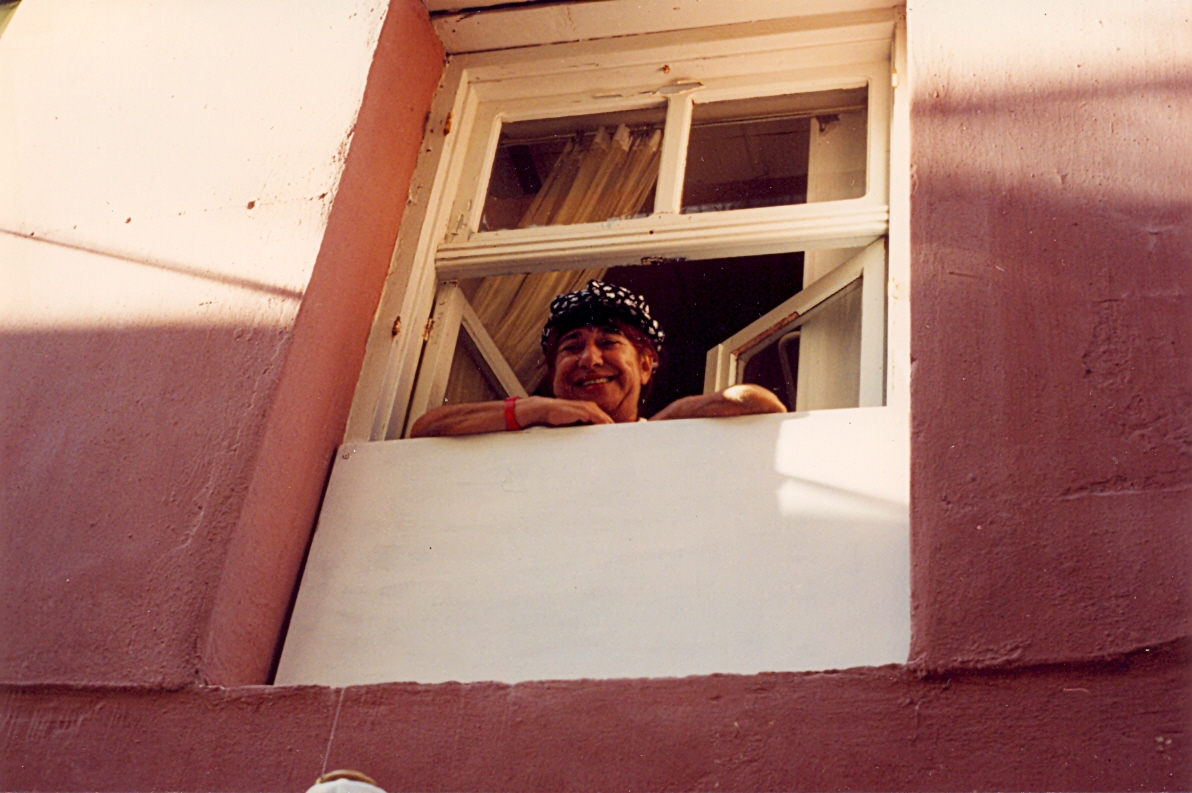
Katerina Anghelaki Rooke in Chania for 'Myth of the City' conference 1995
The Greek poetess Katerina Anghelaki Rooke draws attention to what it means when light regains itself and then the cast of human shadow begins all over again. In her poem 'atmospheric poetry' she explains what it takes so that 'mimosa' prevails once again.
Atmospheric Poetry
How many days and nights of absence
Does the air need
To empty itself from the exhalations
Of your skin
So that mimosa, the pine tree
Prevail again
Together with all the beautiful perfumes
Of impersonal nature?
How long is the time
That a landscape usually holds
This breathtaking combination
Of breeze and a precise step?
For how long will the universe still remind me
Of the meeting with an insignificant glance
When will the light regain
Its absolute predominance
Over the momentary triumph
Of a human shadow?
Katerina Anghelaki Rooke
From: “Translating into Love Life’s End”, Nottingham: Shoestring Press, 2004. p. 23
Shades of grey in black and white by Picasso

The poster is hanging in Picasso's atelier in Paris where he painted Guernica
“Poem” by Pablo Picasso.
Give tear out twist and kill I cross light and
Burn caress and lick embrace and look I ring
Full peals from the bells until they bleed
Frighten the pigeons and make them fly all
Around the dovecot until they fall to the
Ground already exhausted I will stop up all
The windows and the doors with earth and
With your hair I will hang all the birds that
Sing and cut all the flowers I will cradle the
Lamb in my arms and give it my breast to
Be devoured I will wash it with my tears of
Pleasure and of pain and send it to sleep
With the song of my loneliness by Soleares
And engrave with acid the fields of wheat
And oats and watch them die lying face up
In the sun I will wrap the flowers in news-
Paper and I will throw them through the
Window into the stream which repents with
All its sins on its back goes away content
And laughing in spite of all to make its nest
In the cesspool I will break the music of
Wood against the rocks of the waves of the
Sea I will bite the lion’s cheek will make the
Wolf weep with tenderness before a portrait of
Water that lets its arm drop into the bath tub.
Translated by Sir Roland Penrose in London Bulletin, Nos. 15 – 16 (May 15, 1939). Courtesy of Sir Roland Penrose.
The poem by Picasso is amazing. It seems to follow the on twists and illogical transformations lines undergo in front of the eyes of the artists as he crosses over to another plane of visual images.

Most telling in his Guernica painting is how eyes, light and shades are cast to bring out different layers in order to tell the story of human pain. It is a kind of unison of the human cry which makes the Guernica into such a powerful reflection of the fragmentation war leaves in its wake.
Not only wars but the destruction and especially the new borders they leave behind, they cast shadows reaching all the way to underline human despair augmented by feeling to have been abandoned by the rest of the world. There is nothing more terrible of feeling let down, all alone, vulnerable and so helpless against the inflicted injustice.
In the shadow of hard borders - the case of Cyprus
Cyprus is such a case and photography tends to use the black and white to tell the story.


Fleeting shadows can be associated as well when not only a person walks past the window with sunlight falling into the room, but also when a plane flies in between the earth and the sun. It allows a shadow to travel of hill tops, trees and then again out in the open over fields. Such a traveling shadow ripples along.
In the shadow of Guernica


Children beginning in the shade of the trees the Chios-Izmir mural, Chios May 2007
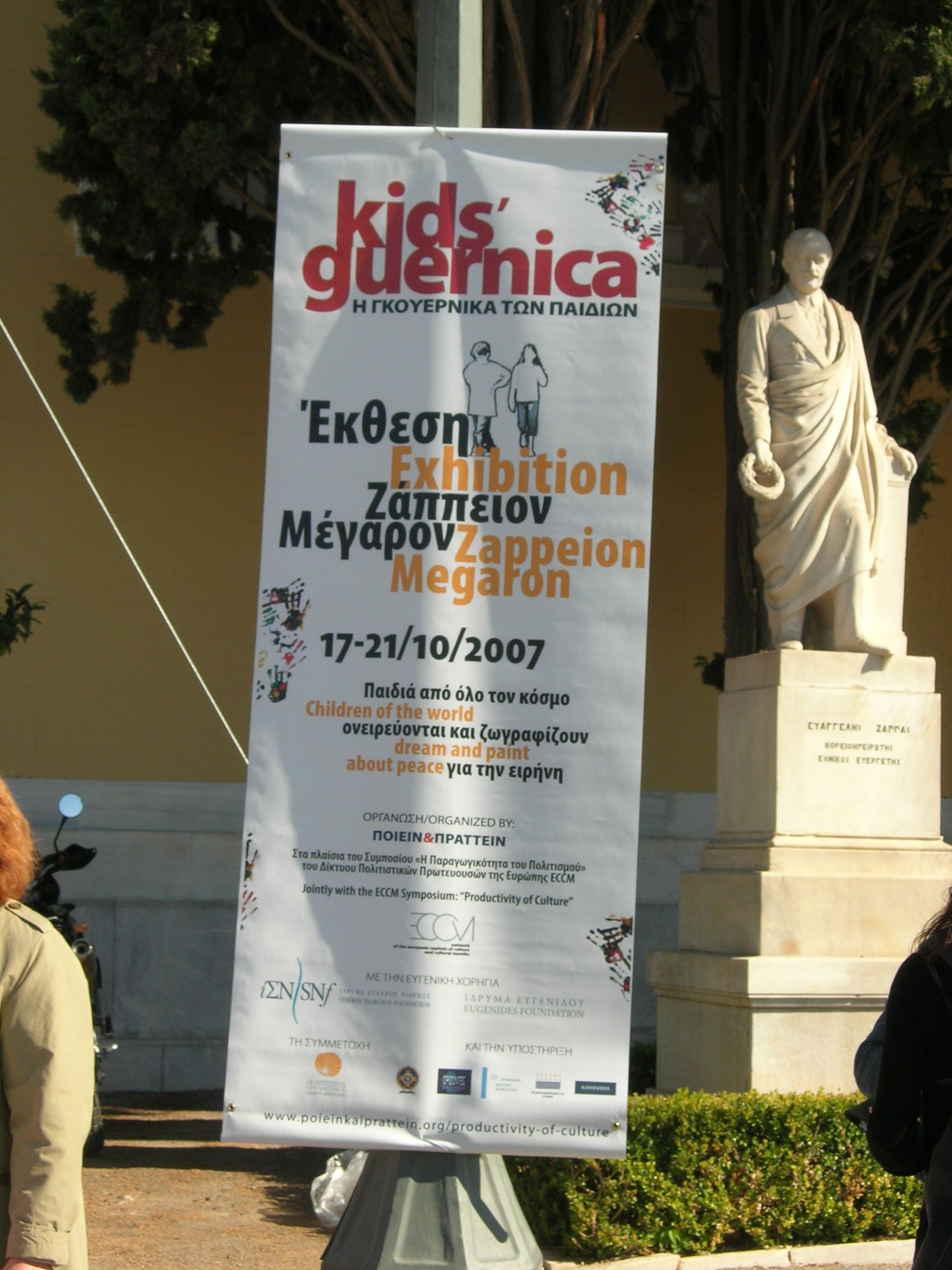
Poster for the Kids' Guernica exhibition at Zappeion, Athens 2007 @hf
War means 'black & white' for adults, but life means for children colour
In terms of Kids' Guernica, the children have plunged into colors. On the other hand adults recall more often war as something merely 'black and white'.

Boy putting finishing touch on mural of Athens 108 school Photo: Kostas Kartelias
Paint pots
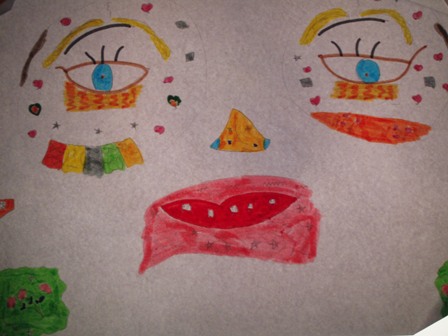
Detail of mural of Athens 108 school @hf 2007
Action in Picasso's Atelier in Paris
No where can this contrast be demonstrated better than through the two murals created in Picasso's atelier.

Open window in Picasso's atelier in Paris @hf 2009
While the official one done under the supervision of adults turned out in reference to Picasso's Guernica as a strict 'black and white' montage of design like images, with planes casting no shadows but just being flat on the surface of a surface used to convey a simple message thought to be an 'effective no against all wars',
Images of planes as symbol of threats on mural made in Picasso's atelier in Paris by children under the coordination of Boris Tissot 4.11.2009 @hf
the children themselves turned to color when they made a special gift to Jad Salman, the only painter working with them in search for free expression.

This little mural shows a different use of the color black by the children. The objects painted as such stand out. They seem to invade the space but as mouse like images they do not pose necessarily an absolute threat. Rather it is a challenge to see how far they can get before being driven back by the colors of life. The children stand united to the right of the central figure, partly a kaleidoscope figure, partly having its own shadow on the one side. But the field where the children can be found is full of soft and soothing colors. It is a terrain of warmth.
An explanation for this difference was given by Boris Tissot when arguing for the methodology he and his collaborators applied as follows:
"When we think about children's art, we tend to make a number of assumptions. For example, we assume children automatically express themselves freely.
It is also conventional to assume that children are "naturally artistic."
Thirdly, it is customary to do away with all limitations.
And lastly, according to custom, childhood is associated with cheery, bright colors.
But perhaps these widespread assumptions are wrong, and we need to get rid of them.
Kids Guernica is the institutional framework of the project. All over the world, children working on the project have produced colorful, joyful visions. And yet the subject is war; the reference to Picasso is clearly stated, as is the intention of the coordinators of Kids’ Guernica and sometimes the paintings need to put an end to the monstrosity of war, to shout "No." And yet…
"Kids" is fully half of "Kids Guernica." Why should the kids necessarily be these happy, innocent creatures they are generally held to be? Why shouldn't they be thinking persons capable of reflecting a profound, individual vision of the world? What would keep them from tackling the problems of humanity with sobriety and depth? For children are /indeed/ part of humanity. They are not a separate category, looking on at adult turpitudes. They participate in and share these turpitudes.
The other half is " Guernica ." The artist's shout; his "NO!"
Guernica is a town: it represents thousands of lives, thousands of deaths… Also, thanks to Picasso, Guernica is the story of an artist's intention. How can wrath and rebellion be depicted? To embark on the same journey, the same phases, the groping, the sketching, the doubts, the decisions, and the techniques is to be immersed in Guernica .
With these considerations in mind, we got 35 children from a community recreation center in the 19th arrondissement of Paris to work and they accepted the challenge: to slip into Picasso's slippers (since we were going to work in his workshop) and paint an immense picture that would try to express a shared sense of revolt. Here is a trace of our eleven days of work…"
Living in the shadow of Guernica - the story of Manuel Gonzales
To tell the story of Guernica means also to read again the article written at that time of the bombardment by the journalist who happened to be just there when it happened. An eye witness could refute the propaganda of Franco who wanted to blame the destruction on the Left.
Living in the shadow of Guernica is most telling for someone like Manuel Gonzales in Gent. His father was one of the children evacuated from Guernica in 1937 and brought with 200 other children to Gent where they found parents willing to adopt them.

Manuel Gonzales telling the children in Picasso's atelier the story of his father, 1st of Nov. 2009
His name reveals already his background. His father came had come from Guernica to Gent. There were evacuated altogether 32 000 children from Guernica in 1937. They were seperated from their parents and thus started not only their journey but also a life long in the shadow of Guernica. 200 of them came to Gent, Manuel's father and his brother two of them. Then what happened was even worse. Their parents had told them to stick always together but during the adoption procedure in Gent the two brothers were seperated. For two years they did not hear from each other. Only one day, by accident, they met in the street as both families had gone out for a walk. Most likely neither parents wanted to tell their adopted son where the brother was living out of fear they would want to live together. Manuel said his father never overcame that trauma of seperation.

A man holding the photo of himself when arriving as a child in Gent

200 Children (of 32 000 which were evacuated from Guernica) at their arrival in Gent in 1937
Elongation of the shadow by Rosa Naparstek
Artistic concepts and linkage to Kids' Guernica were discussed when everyone met in Tallahassee, Florida in January 2010 to celebrate the 15th anniversary of Kids' Guernica. The artists who had engaged themselves in different actions with children and youth had the idea to do an exhibition together in order to show not the murals but their own works. Artists like Savina Tarsitano, Thomas Economacos, Rosa Naparstek, Fatema Nawaz, Boris Tissot and Asit Poddar thought it would be possible to do it in Berlin. Rosa Naparstek had made some contact to a gallery in Kreuzberg. When taking up contact the idea was proposed by Hatto Fischer to call the exhibition "in the shadow of Guernica".
On how to bring the group together, this was discussed but has not as of yet emerged into a definite theme. Rosa Naparstek herself wrote however a short note to start the reflection of how to work together or better how to bring these different artistic abilities together in a common theme?
New York 23. February 2010
"as i was pursuing it...i started to think of the Jung's shadow...of our shadows...of the world's dark side and what it takes to turn it around/open it, transform it (for those of you who know me a little, it's not much of a surprise that I'd be thinking along these lines) and since we don't have that much time...it occurred to me, what if we propose something like "documenting our process around developing our idea/s around " "the elongation of the shadow", how each one of us sees this, what we like, don't like, why we would or would not want to work with this, what comes up as a result of our talking about it, writing about it, being "in process" with it...developing a process that contains our personal and group light/shadow..."
rosa naparstek
« Leipzig exhibition June 1999 | Flash Back Manifesto »




